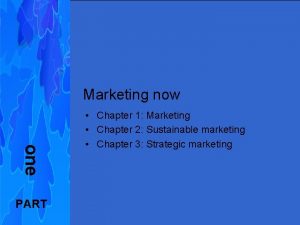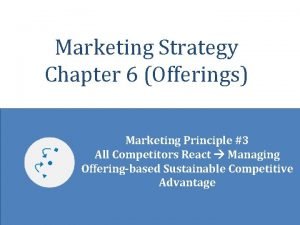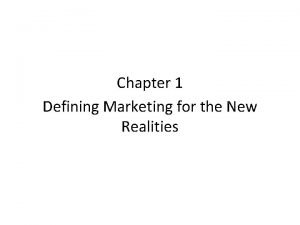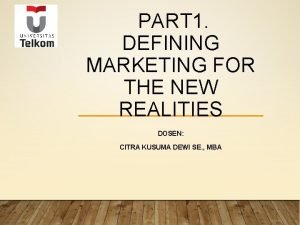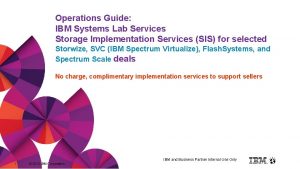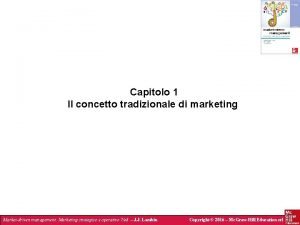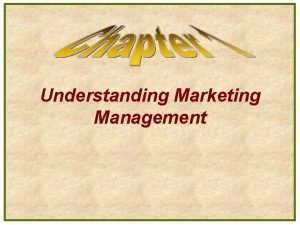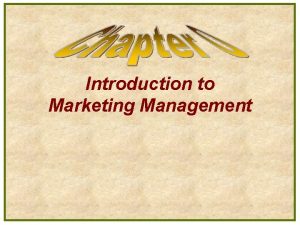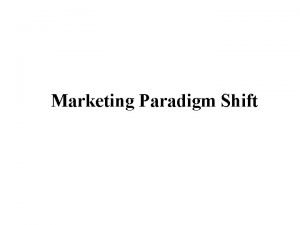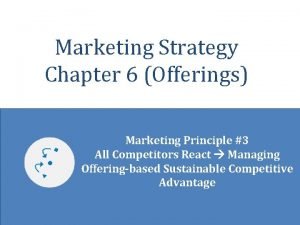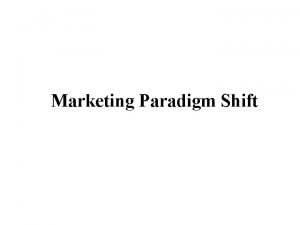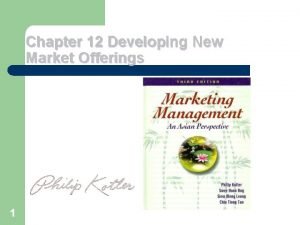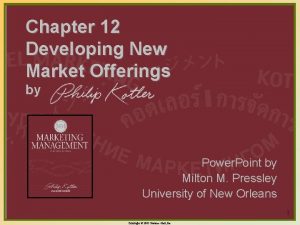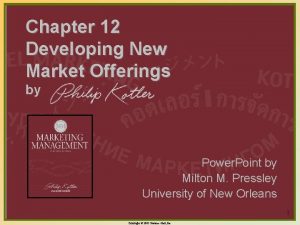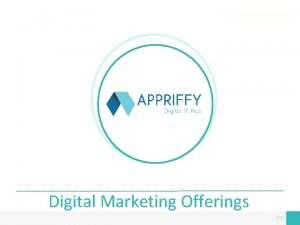20 Introducing New Market Offerings Marketing Management 13



























- Slides: 27

20 Introducing New Market Offerings Marketing Management, 13 th ed

Chapter Questions • What challenges does a company face in developing new products and services? • What organizational structures and processes do managers use to manage new-product development? • What are the main stages in developing new products and services? Copyright © 2009 Pearson Education, Inc. Publishing as Prentice Hall 20 -2

Chapter Questions (cont. ) • What is the best way to manage the new-product development process? • What factors affect the rate of diffusion and consumer adoption of newly launched products and services? Copyright © 2009 Pearson Education, Inc. Publishing as Prentice Hall 20 -3

Categories of New Products New-to-the-world New product lines Additions Improvements Repositionings Cost reductions Copyright © 2009 Pearson Education, Inc. Publishing as Prentice Hall 20 -4

The World’s Most Innovative Companies • • Apple Google Toyota General Electric Microsoft Procter & Gamble 3 M Walt Disney • • IBM Sony Wal-Mart Honda Starbucks Target BMW Samsung Copyright © 2009 Pearson Education, Inc. Publishing as Prentice Hall 20 -5

Seven Notions of Innovation • See the future through the eyes of your customer • Intellectual property and brand power are key assets • Use digital technology to create tools for customers • Build a championship team • Innovation is a state of mind • Speed is critical, so push your organization • Partner up if you’re not the best Copyright © 2009 Pearson Education, Inc. Publishing as Prentice Hall 20 -6

Factors That Limit New Product Development • • Shortage of ideas Fragmented markets Social and governmental constraints Cost of development Capital shortages Faster required development time Shorter product life cycles Copyright © 2009 Pearson Education, Inc. Publishing as Prentice Hall 20 -7

What is a Venture Team? A venture team is a cross-functional group charged with developing a specific product or business; intrapreneurs are relieved of other duties and provided a budget and time frame. Copyright © 2009 Pearson Education, Inc. Publishing as Prentice Hall 20 -8

Criteria for Staffing Venture Teams • • • Desired team leadership style Desired level of leader expertise Team member skills and expertise Level of interest in concept Potential for personal reward Diversity of team members Copyright © 2009 Pearson Education, Inc. Publishing as Prentice Hall 20 -9

Ways to Find Great New Ideas • Run informal sessions with customers • Allow time off for technical people to putter on pet projects • Make customer brainstorming a part of plant tours • Survey your customers • Undertake “fly on the wall” research to customers Copyright © 2009 Pearson Education, Inc. Publishing as Prentice Hall 20 -10

More Ways to Find Great Ideas • Use iterative rounds with customers • Set up a keyword search to scan trade publications • Treat trade shows as intelligence missions • Have employees visit supplier labs • Set up an idea vault Copyright © 2009 Pearson Education, Inc. Publishing as Prentice Hall 20 -11

Drawing Ideas from Customers • Observe customers using product • Ask customers about problems with products • Ask customers about their dream products • Use a customer advisory board or a brand community of enthusiasts to discuss product Copyright © 2009 Pearson Education, Inc. Publishing as Prentice Hall 20 -12

Idea Generation: Creativity Techniques • • • Attribute listing Forced relationships Morphological analysis Reverse assumption analysis New contexts Mind mapping Copyright © 2009 Pearson Education, Inc. Publishing as Prentice Hall 20 -13

Lateral Mapping • • • Gas stations + food Cafeteria + Internet Cereal + snacking Candy + toy Audio + portable Copyright © 2009 Pearson Education, Inc. Publishing as Prentice Hall 20 -14

Variations on Failure • Absolute product failure • Partial product failure • Relative product failure Copyright © 2009 Pearson Education, Inc. Publishing as Prentice Hall 20 -15

Concepts in Concept Development • • • Product idea Product concept Category concept Brand concept Concept testing Copyright © 2009 Pearson Education, Inc. Publishing as Prentice Hall 20 -16

Concept Testing • • • Communicability and believability Need level Gap level Perceived value Purchase intention User targets, purchase occasions, purchasing frequency Copyright © 2009 Pearson Education, Inc. Publishing as Prentice Hall 20 -17

Marketing Strategy • Target market’s size, structure, and behavior • Planned price, distribution, and promotion for Year One • Long-run sales and profit goals and marketing-mix strategy over time Copyright © 2009 Pearson Education, Inc. Publishing as Prentice Hall 20 -18

Product Development • Quality function deployment (QFD) • Customer attributes • Engineering attributes Copyright © 2009 Pearson Education, Inc. Publishing as Prentice Hall 20 -19

Prototype Testing • Alpha testing • Beta testing • Rank-order method • Paired-comparison method • Monadic-rating method • Market testing Copyright © 2009 Pearson Education, Inc. Publishing as Prentice Hall 20 -20

Consumer Goods Market Testing • • Sales-Wave Research Simulated Test Marketing Controlled Test Marketing Test Markets Copyright © 2009 Pearson Education, Inc. Publishing as Prentice Hall 20 -21

Test Market Decisions • • • How many test cities? Which cities? Length of test? What information to collect? What action to take? Copyright © 2009 Pearson Education, Inc. Publishing as Prentice Hall 20 -22

Timing of Market Entry • First entry • Parallel entry • Late entry Copyright © 2009 Pearson Education, Inc. Publishing as Prentice Hall 20 -23

Criteria for Choosing Rollout Markets • • Market potential Company’s local reputation Cost of filling pipeline Cost of communication media Copyright © 2009 Pearson Education, Inc. Publishing as Prentice Hall 20 -24

What is Adoption? Adoption is an individual’s decision to become a regular user of a product. Copyright © 2009 Pearson Education, Inc. Publishing as Prentice Hall 20 -25

Stages in the Adoption Process Awareness Interest Evaluation Trial Adoption Copyright © 2009 Pearson Education, Inc. Publishing as Prentice Hall 20 -26

Characteristics of an Innovation • • • Relative advantage Compatibility Complexity Divisibility Communicability Copyright © 2009 Pearson Education, Inc. Publishing as Prentice Hall 20 -27
 New market offering
New market offering Market offerings are limited to physical products
Market offerings are limited to physical products Offerings marketing
Offerings marketing What forces are defining the new marketing realities?
What forces are defining the new marketing realities? Introducing and naming new products and brand extensions
Introducing and naming new products and brand extensions Introducing and naming new products and brand extensions
Introducing and naming new products and brand extensions Leader follower challenger nicher
Leader follower challenger nicher Market segmentation target and positioning
Market segmentation target and positioning The actual and potential rival offerings
The actual and potential rival offerings New consumer capabilities and new company capabilities
New consumer capabilities and new company capabilities Lsu law course offerings
Lsu law course offerings Ellen white on tithes and offerings
Ellen white on tithes and offerings Consulting service offerings
Consulting service offerings Equity international management
Equity international management Ibm lab services
Ibm lab services Market-driven management. marketing strategico e operativo
Market-driven management. marketing strategico e operativo Marketing meaning in marketing management
Marketing meaning in marketing management Marketing management objective
Marketing management objective Marketing management introduction
Marketing management introduction Introducing quotes with signal phrases
Introducing quotes with signal phrases Rowe concise introduction to linguistics download
Rowe concise introduction to linguistics download 1941-1882
1941-1882 Quote explanation sentence starters
Quote explanation sentence starters Counterclaim in writing
Counterclaim in writing Unit 1 about myself
Unit 1 about myself How to introduce yourself in training session
How to introduce yourself in training session Ma
Ma Echo verse poem examples
Echo verse poem examples

